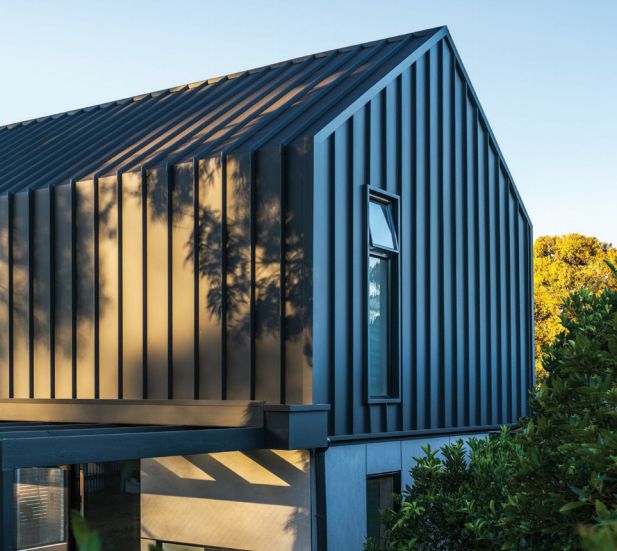Cladding is important in architectural design and construction because it not only improves a building’s visual appeal but also provides protection and insulation. Among the many alternatives available, two stand out: Standing Seam Cladding and Alucobond Cladding. Standing Seam Cladding and Alucobond Cladding. In this comprehensive guide, we delve into the intricacies of these two types of cladding, exploring their features, benefits, applications, and sustainability aspects.
Standing Seam Cladding:
Standing seam cladding is a type of metal cladding that features vertical seams between metal panels. These seams are raised above the level of the panel surface, creating a distinctive, linear aesthetic. Standing seam cladding is typically made from materials such as aluminium, steel, zinc, or copper, offering durability and weather resistance.
Features:
Vertical Seams: The defining feature of standing seam cladding is its vertical seams, which provide a clean, modern look.
Material Options: Standing seam cladding may be made from a range of materials, each with its own set of qualities and aesthetics.
Customisation: It may be customised in terms of colour, profile, and panel width to meet the design specifications of a project.
Weather Resistance: Standing seam cladding is highly weather-resistant, making it suitable for use in various climates.
Benefits:
Aesthetic Appeal: Standing seam cladding adds a sleek, modern look to buildings, making it a popular choice for contemporary designs.
Durability: Metal standing seam cladding is extremely robust, lasting for decades with minimum maintenance.
Weather Resistance: Standing seam cladding provides excellent protection against the elements, including wind, rain, and snow.
Low Maintenance: Standing seam cladding requires minimal maintenance, making it a cost-effective choice over the long term.
Applications:
Residential Buildings: Standing seam cladding is often used in residential buildings, particularly in modern and contemporary designs.
Commercial Buildings: It is also popular in commercial buildings, such as offices, retail stores, and hotels.
Industrial Buildings: Standing seam cladding is suitable for industrial buildings, providing both functionality and aesthetic appeal.
Sustainability:
Recyclability: Metal standing seam cladding is highly recyclable, making it an environmentally friendly choice.
Energy Efficiency: Standing seam cladding can improve a building’s energy efficiency, lowering energy usage and carbon emissions.
Alucobond Cladding:
Alucobond cladding is a composite panel composed of two thin aluminium sheets bonded to a core material, often polyethylene. This sandwich design offers Alucobond panels a high strength-to-weight ratio, allowing them to be lightweight while being robust and durable.
Features:
Composite Construction: Alucobond panels consist of two aluminium sheets bonded to a core material, providing a lightweight yet strong cladding solution.
Colour Options: Alucobond panels come in a variety of colours and finishes, enabling a high level of customisation.
Weather Resistance: Alucobond panels are highly weather-resistant, making them suitable for use in vacuums.
Ease of Installation: Alucobond panels are easy to install, reducing labour costs and installation time.
Benefits:
Aesthetic Versatility: Alucobond panels offer a wide range of design possibilities, including flat, curved, and three-dimensional shapes.
Durability: Alucobond panels are highly durable and resistant to fading, weathering, and corrosion.
Low Maintenance: Alucobond panels require minimal maintenance, making them a cost-effective choice over the long term.
Energy Efficiency: Alucobond panels can increase a building’s energy efficiency by insulating and minimising heat transmission.
Fire Resistance: Alucobond panels are fire-resistant, offering added safety and peace of mind.
Applications:
Commercial Buildings: Alucobond cladding is widely utilised in commercial structures, including offices, retail stores, and shopping malls.
Residential Buildings: It is also used in residential buildings, particularly in modern and contemporary designs.
Industrial Buildings: Alucobond cladding is suitable for industrial buildings, providing both functionality and aesthetic appeal.
Sustainability:
Recyclability: Alucobond panels are recyclable, making them an environmentally friendly choice.
Energy Efficiency: By increasing a building’s energy efficiency, Alucobond cladding can assist in reducing energy consumption and carbon emissions.
Comparison:
Aesthetic Appeal: Standing seam cladding’s vertical seams give it a sleek, modern appearance, whilst Alucobond cladding’s colour selections and adaptability allow for a wide range of design possibilities.
Durability: Although both standing seam and Alucobond cladding are extremely robust, metal standing seam cladding may have a tiny advantage in terms of lifetime.
Weather Resistance: Both types of cladding are highly weather-resistant, making them suitable for use in various climates.
Energy Efficiency: Both standing seam and Alucobond cladding can help a building’s energy efficiency. However, Alucobond panels may provide higher insulation.
Cost: The cost of standing seam cladding and Alucobond cladding can vary depending on the material, design, and installation method.
Conclusion:
In conclusion, both standing seam cladding and Alucobond cladding offer unique features and benefits, making them suitable for a wide range of applications. While standing seam cladding provides a sleek, modern look with its vertical seams, Alucobond cladding offers versatility and design possibilities. Finally, the decision between the two will be determined by your project’s requirements, such as budget, aesthetic preferences, and performance demands.


